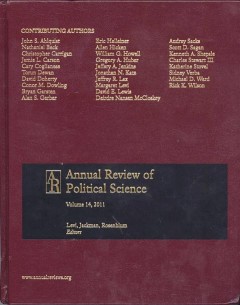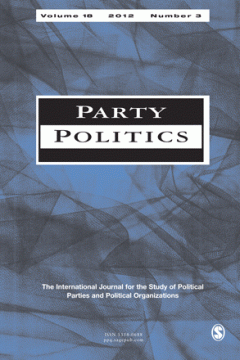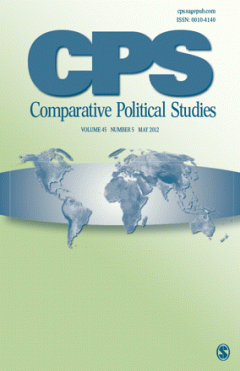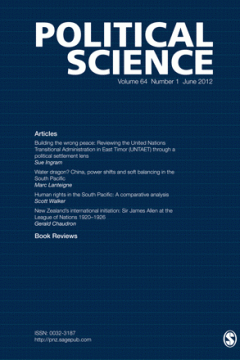Filter by

Clientelism
Clientelism is characterized by the combination of particularistic targeting and contingency-based exchange. This method of contingent exchange thrives in both autocracies and democracies. It exists in a large variety of cultural contexts. Confronted with economic development, clientelism fades away in some political contexts but adapts and survives in others. This article explores our understa…
- Edition
- Volume 14, 2011 p. 289–310
- ISBN/ISSN
- 10942939
- Collation
- p. 289–310
- Series Title
- Annual Review of Political Science
- Call Number
- -

Political Economy Models of Elections
We review a large formal literature on economic models of voting and electoral politics. We discuss two broad classes of model: those focusing on preference aggregation and those that look at elections as mechanisms of information aggregation. We also explore the role of elections in situations of asymmetric information, where politicians take hidden actions or are otherwise better informed abo…
- Edition
- Volume 14, 2011 p. 311–330
- ISBN/ISSN
- 10942939
- Collation
- p. 311–330
- Series Title
- Annual Review of Political Science
- Call Number
- -

Modeling Dynamics in Time-Series–Cross-Section Political Economy Data
This article deals with a variety of dynamic issues in the analysis of time-series�cross-section (TSCS) data. Although the issues raised are general, we focus on applications to comparative political economy, which frequently uses TSCS data. We begin with a discussion of specification and lay out the theoretical differences implied by the various types of dynamic models that can be estimated. I…
- Edition
- Volume 14, 2011 p. 331-352
- ISBN/ISSN
- 10942939
- Collation
- p. 331-352
- Series Title
- Annual Review of Political Science
- Call Number
- -

Voting Technologies
A renewed, energetic interest in voting technologies erupted in political science following the 2000 presidential election. Spawned initially by the recount controversy in Florida, the literature has grown to consider the effects of voting technologies on the vote choice more generally. This literature has explained why localities have the voting technologies (lever machines, punch cards, etc.)…
- Edition
- Volume 14, 2011 p. 353-378
- ISBN/ISSN
- 10942939
- Collation
- p. 353-378
- Series Title
- Annual Review of Political Science
- Call Number
- -

Policy-seeking parties in multiparty systems: Influence or purity?
According to the standard policy-seeking model of party behaviour, a party should always want to join a coalition if its inclusion would decrease the policy distance between the party and the winning coalition. However, in multiparty systems where no party has a majority, policy influence always comes at a cost to the party�s preferred policy. A party has to moderate its own policy principles i…
- Edition
- Volume 18, Number 3, May 2012 p. 297-314
- ISBN/ISSN
- 1354-0688
- Collation
- p. 297-314
- Series Title
- Party Politics
- Call Number
- -

New party organization in Western Europe: Of party hierarchies, stratarchies …
Scholarly work on models of party organization tends to treat stratarchy and hierarchy as analytical opposites. Based on two different visions of stratarchy that co-exist in the literature, this article presents a threefold typology locating party stratarchy as a model between party hierarchy, as one counter-image, and party federation, as the other. The types differ in the extent to which core…
- Edition
- Volume 18, Number 3, May 2012 p. 315-336
- ISBN/ISSN
- 1354-0688
- Collation
- p. 315-336
- Series Title
- Party Politics
- Call Number
- -

One-party rule or multiparty competition? Chinese attitudes to party system a…
This article tests multifactor explanations for variance among Chinese citizens' attitudes to two related but separable party system concepts: the appropriateness of the current one-party system for China today, and the more abstract notion that multiple parties lead to chaos. Using data from The China Survey, conducted with a nationwide sample in 2008, the authors find that feelings of satisfa…
- Edition
- Volume 18, Number 3, May 2012 p. 337-347
- ISBN/ISSN
- 1354-0688
- Collation
- p. 337-347
- Series Title
- Party Politics
- Call Number
- -

Multi-party governance: Managing the unity-distinctiveness dilemma in executi…
In democracies where no party enjoys a parliamentary majority, various multi-party governance arrangements have evolved to accommodate the respective interests of the parties involved. Such arrangements reflect, among other things, the political imperatives facing the parties in question, in particular the quest for an effective and durable government (which typically requires significant inter…
- Edition
- Volume 18, Number 3, May 2012 p. 349-368
- ISBN/ISSN
- 1354-0688
- Collation
- p. 349-368
- Series Title
- Party Politics
- Call Number
- -

Scripture, structure and the formation of Catholic parties: The case of Venez…
What accounts for the virtual absence of new Catholic parties in Latin America over the past four decades? From the late nineteenth to the mid-twentieth centuries, Catholic activists organized a variety of political parties in the region. Yet since the 1970s, despite the dramatic expansion of political opportunities in Catholic-majority countries, Catholicism has played only a marginal role in …
- Edition
- Volume 18, Number 3, May 2012 p. 369-390
- ISBN/ISSN
- 1354-0688
- Collation
- p. 369-390
- Series Title
- Party Politics
- Call Number
- -

Financing democracy in Japan: The allocation and consequences of government s…
In 1994, the Japanese Diet implemented a system of public assistance for political parties which many hoped would encourage party-centred rather than candidate-centred campaigns. This study examines some of the consequences of this system for party organizations and politicians. Using data culled from official subsidy and campaign finance reports, two empirical questions are addressed: first, h…
- Edition
- Volume 18, Number 3, May 2012 p. 391-408
- ISBN/ISSN
- 1354-0688
- Collation
- p. 391-408
- Series Title
- Party Politics
- Call Number
- -

From local to national: Explaining the formation of the Australian Green Party
The rise of green parties in Australia follows a path that is well documented in the literature; the inability of other parties to accommodate environmental concerns, the increasing salience of green issues for governments and an electoral regime that permits party insurgency. This article examines how these factors have operated in Australia, and the extent to which a distinctive federal struc…
- Edition
- Volume 18, Number 3, May 2012 p. 409-425
- ISBN/ISSN
- 1354-0688
- Collation
- p. 409-425
- Series Title
- Party Politics
- Call Number
- -

Factions with clout: Presidential cabinet coalition and policy in the Uruguay…
We investigate bill passage by party factions in Uruguay and show that those joining cabinet coalitions earn policy influence. The policy advantage of coalition is therefore not collected by the president alone, as often implied: partners acquire clout in law-making and use it to pass bills of their own and to strike deals with outside factions. Analysis of all bills initiated between 1985 and …
- Edition
- Volume 18, Number 3, May 2012 p. 427-451
- ISBN/ISSN
- 1354-0688
- Collation
- p. 427-451
- Series Title
- Party Politics
- Call Number
- -

Does Cheating Pay? The Effect of Electoral Misconduct on Party Systems
This article examines the effect of electoral misconduct on party systems in new electoral regimes. The authors distinguish between different forms of electoral misconduct and argue that preelection tools�which aim to deter opposition parties and their supporters and create a biased information environment�exert a �psychological� effect on parties and voters, whereas ballot fraud exerts a direc…
- Edition
- Volume 45, Number 5 May 2012 p. 575-605
- ISBN/ISSN
- 0010-4140
- Collation
- p. 575-605
- Series Title
- Comparative Political Studies
- Call Number
- -

Who Fears What? Explaining Far-Right-Wing Preference in Europe by Distinguish…
This contribution aims, first, to determine whether support for the far right is based on perceptions of cultural or economic threats posed by immigrants in 11 European countries. Second, it seeks to reanalyze the question of whether class is an important explanation for support for the far right using new measures of class and, related to this, to determine the extent to which class interacts …
- Edition
- Volume 45, Number 5 May 2012 p. 547-574
- ISBN/ISSN
- 0010-4140
- Collation
- p. 547-574
- Series Title
- Comparative Political Studies
- Call Number
- -

Partisan Embedding of Liberalism: How Trade, Investment, and Immigration Affe…
Political scientists have long debated how economic globalization influences national social policies, but they have so far not explored the political demands of political parties implicitly underlying such influence. This article explores such demands to see how globalization affects partisan-political demands for the welfare state in industrialized countries. It argues that political parties …
- Edition
- Volume 45, Number 5 May 2012 p. 606-635
- ISBN/ISSN
- 0010-4140
- Collation
- Volume 45, Number 5 May 2012 p. 606-635
- Series Title
- Comparative Political Studies
- Call Number
- -

The Spillover Effects of Participatory Governance: Evidence From Community-Ma…
In contrast to more pessimistic studies, the authors find evidence that civic participation in one domain of public life can lead to more participation elsewhere, what they call spillover effects. The authors� findings are based on a large survey�among the broadest in its class�of participants in community-managed schools throughout rural Honduras and Alta Verapaz, Guatemala. Despite various ob…
- Edition
- Volume 45, Number 5 May 2012 p. 636-666
- ISBN/ISSN
- 0010-4140
- Collation
- p. 636-666
- Series Title
- Comparative Political Studies
- Call Number
- -

Building the wrong peace: Reviewing the United Nations Transitional Administr…
The United Nations Transitional Administration in East Timor (UNTAET) was established by the UN Security Council on 25 October 1999 to administer the territory of East Timor towards independence in the wake of its violent separation from Indonesia. UNTAET largely fulfilled the elements of the security and governance mandate conferred on it by the Security Council, but this was not sufficient to…
- Edition
- Volume 64, Number 1 June 2012 p. 3-20
- ISBN/ISSN
- 0032-3187
- Collation
- p. 3-20
- Series Title
- Political Science
- Call Number
- -

Water dragon? China, power shifts and soft balancing in the South Pacific
As China expands its foreign policy interests and strategic power further into the Pacific Ocean, a division is developing between Beijing�s policies in the western Pacific (around East and Southeast Asia), which have begun to assume a more assertive strategic role, and the South Pacific where China is instead seeking to engage in �soft balancing� power behaviour towards American and by extensi…
- Edition
- Volume 64, Number 1 June 2012 p. 21-38
- ISBN/ISSN
- 0032-3187
- Collation
- p. 21-38
- Series Title
- Political Science
- Call Number
- -

Human rights in the South Pacific: A comparative analysis
To date, no research has attempted to evaluate human rights in the Pacific region in comparative perspective. Employing commonly used cross-national measures of basic human rights, the author examines how well regimes in the region respect political and civil rights as well as the right to physical integrity. The results reveal that, as regards political and civil rights, the region appears to …
- Edition
- Volume 64, Number 1 June 2012 p. 39-61
- ISBN/ISSN
- 0032-3187
- Collation
- p. 39-61
- Series Title
- Political Sciences
- Call Number
- -

New Zealand’s international initiation: Sir James Allen at the League of Na…
New Zealand was a founding member of the League of Nations in 1919 but there was no enthusiasm for the new organisation in Wellington. The Massey government only saw unwelcome obligations resulting from its membership, and the League�s great quest for a comprehensive agreement on security and arbitration was regarded as a threat to the British Empire by its most loyal dominion. Obliged to send …
- Edition
- Volume 64, Number 1 June 2012 p. 62-80
- ISBN/ISSN
- 0032-3187
- Collation
- p. 62-80
- Series Title
- Political Science
- Call Number
- -
 Computer Science, Information & General Works
Computer Science, Information & General Works  Philosophy & Psychology
Philosophy & Psychology  Religion
Religion  Social Sciences
Social Sciences  Language
Language  Pure Science
Pure Science  Applied Sciences
Applied Sciences  Art & Recreation
Art & Recreation  Literature
Literature  History & Geography
History & Geography